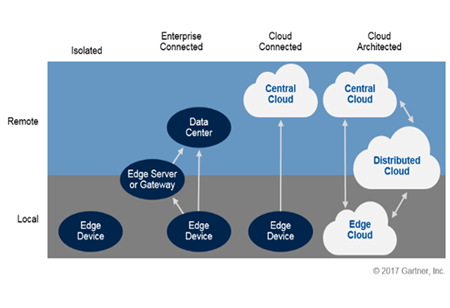
Edge Computing & the Modular Data Centre Boost


Prasanna Sarambale, CEO - Data Center Business & Group Head - Business Development, Sterling and Wilson
When your business commitments hinge on whether a delivery van starts properly on Monday morning, or the time it spends idling at traffic gridlocks, every second counts. Scale it up to thousands of fleet vehicles, and it is a gargantuan task one that the logistics behemoth United Parcel Service(UPS) knows all too well.
UPS deals with such eventualities using data from 200 embedded sensors in each vehicle. These inputs bolster UPS’ big data analytics strategy. It helps UPS’fleet reduce annual travel by 85 million miles and save 8.5 million gallons of fuel. This use case is just a precursor to radical developments powered by Internet of Things (IoT), big data, analytics and artificial intelligence (AI).
Global forecasts indicate average daily data consumption in the range of 1.5 GB of traffic per person by 2020. Throw in expected traffic from developments such as smart hospitals(three TB per day for a hospital)and connected factories(three PB per day for each factory). Daily data traffic volumes from self driving cars will amount to four TB per day for every vehicle not a rosy time ahead for bandwidth management teams.
Gartner studies estimate the number of connected sensors and endpoints to be more than 20 billion by 2020. Such ecosystems place mammoth demands on the bandwidth front. The data centre sphere as we know it, is set to witness a sea of change. Emerging applications driven by trends such as IoT, 5G cellular connectivity, and machine to machine communication call for intelligent data processing across the network. Edge computing and modular data centres make their presence felt at this point.
With its origins in mesh networking and distributed processing, edge computing is an evolving concept. It marks a shift of computing capabilities closer to geographically distant data sources for optimal response times, superior user experiences, and cost-effective infrastructure. Figure 1: Evolving DC, cloud and edge computing synergies provides a broad overview of upcoming infrastructure models.

As is clear from Figure-1,enterprise connected, cloud connected and cloud architected edge computing models will be of primary importance to most enterprises. Data harvested from edge devices such as sensors is processed at the edge server or edge cloud layers.
Innovative rollouts are underway in verticals such as retail, telecom and finance. For example, digital trialrooms use virtual reality and image recognition to allow customer fit outs for clothing prior to online purchases. Modular data centres can cache such compute intensive tasks for seamless and immersive customer experiences. In case of Telecom, service
providers deploy modular data centres to tackle network service optimisation and regulatory compliance requirements.
Emergence of Modular Compute
Modular data centres integrate compute, storage, power, cooling, fire detection, and security into prefabricated form factors. Commissioning phase is minimal (in the order of weeks) for these compute blocks. This makes it ideal for rapid or makeshift deployment scenarios such as those in telecom, power or financial sectors.
IDC predictions indicate that at least 40 percent of IoT data will be managed at the network edge itself in 2019. In this context on-site compute capabilities offered by modular data centres ensure exponentially high latency gains. For example, implementers of modular data centres at the edge level often witness latency reduction from hundreds of milliseconds to less than 10 milliseconds. The accompanying bandwidth savings ensure quick ROI for associated line items.
In this context, a new high-performance computing (HPC) implementation currently underway at the European Organization for Nuclear Research (CERN) is an interesting case study. CERN’s Large Hadron Collider ‘beauty’ project (LHCb) will be backed by a prefabricated 3MW HPC data centre facility spread over 32,500 square feet.
Since modular data centres utilise integrated hardware, it eliminates the need for specialised support skillsets. Comprehensive management software allows remote management and administration. These setups also feature integration with popular data centre infrastructure management (DCIM) suites. This ensures manpower and administration savings. Rise in adoption will goad leading vendors to offer management services.
Real estate savings due to smaller footprints is another tangible benefit. The compact modular nature also translates to costeffective expansion. Lower power utilisation efficiency (PUE) factors are inherent to modular data centres. Easier and cost-effective data centre certification is yet another advantage.
Right Fits for India Inc.
Forerunners of modular data centre adoption in India include IoT, telecom, colocation, financial, content delivery and data intensive energy vertical requirements. Computing requirements at inaccessible remote locations are also ideal candidates for modular data centres.
Modular data centres at cellular towers are among the commonly cited edge computing installations. Powered by grid power (on cellular towers colocated with power grid transmission lines) or gensets, these prefabricated modular units find use in smart cities, healthcare, retail, education, autonomous vehicles, and IoT applications. Branch (or remote) offices and SMBs are also increasingly opting for these on-demand compute blocks.
Edge computing calls for data hubs at multiple levels (local, urban and regional) to provide communication, compute and storage to the data source. Modular data centres are increasingly popular as local hubs. The distributed nature of such enterprise workloads will result in innovations especially in India’s upcoming Smart Cities.
Mega technology trends characterised by exponential data traffic growth are set to rewrite existing enterprise computing game plans. Next generation business models call for rapid infrastructure and application scale out requirements even as it seamlessly integrates existing infrastructure. On demand compute blocks such as modular data centres are all set to rapidly empower such visions.
Emergence of Modular Compute
Modular data centres integrate compute, storage, power, cooling, fire detection, and security into prefabricated form factors. Commissioning phase is minimal (in the order of weeks) for these compute blocks. This makes it ideal for rapid or makeshift deployment scenarios such as those in telecom, power or financial sectors.
Edge computing calls for data hubs at multiple levels (local, urban and regional) to provide communication, compute and storage to the data source
IDC predictions indicate that at least 40 percent of IoT data will be managed at the network edge itself in 2019. In this context on-site compute capabilities offered by modular data centres ensure exponentially high latency gains. For example, implementers of modular data centres at the edge level often witness latency reduction from hundreds of milliseconds to less than 10 milliseconds. The accompanying bandwidth savings ensure quick ROI for associated line items.
In this context, a new high-performance computing (HPC) implementation currently underway at the European Organization for Nuclear Research (CERN) is an interesting case study. CERN’s Large Hadron Collider ‘beauty’ project (LHCb) will be backed by a prefabricated 3MW HPC data centre facility spread over 32,500 square feet.
Since modular data centres utilise integrated hardware, it eliminates the need for specialised support skillsets. Comprehensive management software allows remote management and administration. These setups also feature integration with popular data centre infrastructure management (DCIM) suites. This ensures manpower and administration savings. Rise in adoption will goad leading vendors to offer management services.
Real estate savings due to smaller footprints is another tangible benefit. The compact modular nature also translates to costeffective expansion. Lower power utilisation efficiency (PUE) factors are inherent to modular data centres. Easier and cost-effective data centre certification is yet another advantage.
Right Fits for India Inc.
Forerunners of modular data centre adoption in India include IoT, telecom, colocation, financial, content delivery and data intensive energy vertical requirements. Computing requirements at inaccessible remote locations are also ideal candidates for modular data centres.
Modular data centres at cellular towers are among the commonly cited edge computing installations. Powered by grid power (on cellular towers colocated with power grid transmission lines) or gensets, these prefabricated modular units find use in smart cities, healthcare, retail, education, autonomous vehicles, and IoT applications. Branch (or remote) offices and SMBs are also increasingly opting for these on-demand compute blocks.
Edge computing calls for data hubs at multiple levels (local, urban and regional) to provide communication, compute and storage to the data source. Modular data centres are increasingly popular as local hubs. The distributed nature of such enterprise workloads will result in innovations especially in India’s upcoming Smart Cities.
Mega technology trends characterised by exponential data traffic growth are set to rewrite existing enterprise computing game plans. Next generation business models call for rapid infrastructure and application scale out requirements even as it seamlessly integrates existing infrastructure. On demand compute blocks such as modular data centres are all set to rapidly empower such visions.